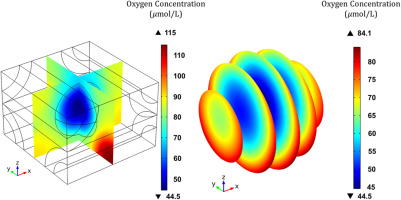当前位置:
X-MOL 学术
›
J. Membr. Sci.
›
论文详情
Our official English website, www.x-mol.net, welcomes your
feedback! (Note: you will need to create a separate account there.)
OXYGEN TRANSPORT IN HOLLOW FIBER MEMBRANE BIOREACTORS FOR HEPATIC 3D CELL CULTURE: A PARAMETRIC STUDY
Journal of Membrane Science ( IF 8.4 ) Pub Date : 2017-12-01 , DOI: 10.1016/j.memsci.2017.09.024 Shervin Khakpour , Alberto Di Renzo , Efrem Curcio , Francesco Paolo Di Maio , Lidietta Giorno , Loredana De Bartolo
Journal of Membrane Science ( IF 8.4 ) Pub Date : 2017-12-01 , DOI: 10.1016/j.memsci.2017.09.024 Shervin Khakpour , Alberto Di Renzo , Efrem Curcio , Francesco Paolo Di Maio , Lidietta Giorno , Loredana De Bartolo

|
Abstract Hepatic cell cultures are exploited for different applications in liver disease studies, drug toxicity testing and bioartificial liver (BAL) devices. Despite the development of various 3D cell culture systems, mass transfer properties and limitations, especially oxygen supply, still remain a controversial topic. In this paper, oxygen transport in a convection-enhanced, crossed-configuration hollow fibre membrane bioreactor hosting hepatocyte spheroids has been investigated through coupled free/porous media flow hydrodynamics and mass transfer modelling using finite-element simulations. Starting from experimental measurements of the oxygen concentration in the bioreactor, a systematic parametric study was performed to evaluate the effect of different parameters – oxygen partial pressure, perfusion rate, hollow fibre spacing, spheroid size, Michaelis-Menten kinetics for oxygen uptake and porosities of the spheroid and the membrane – on dissolved oxygen concentration profile. These parameters were studied in relation to dimensionless groups and variables. Among the operational conditions, oxygen concentration was much more influential than perfusion rate. As for the Michaelis-Menten parameters, oxygen concentration profile inside the spheroids was strongly affected by the maximum consumption rate (Vmax) and weakly dependent on the constant KM. Culturing smaller spheroids minimized the exposure of cells to hypoxic conditions, owing to the short diffusive penetration depth of oxygen especially at low porosities (0.2). An in vivo-like microenvironment in terms of physiological oxygen concentration range was achieved in large spheroids (400 µm diameter) at spheroid porosity of 0.47. Membrane porosity also affected the intra-spheroid oxygen concentration and an improvement in oxygen supply to the spheroids could be achieved by reducing the corresponding transfer resistances. The mechanical stress on the spheroid surfaces was found to be within the tolerated ranges. Overall, the most important parameters for optimization of the bioreactor were identified.
中文翻译:

用于肝 3D 细胞培养的中空纤维膜生物反应器中的氧运输:参数研究
摘要 肝细胞培养在肝病研究、药物毒性测试和生物人工肝 (BAL) 装置中具有不同的应用。尽管开发了各种 3D 细胞培养系统,但传质特性和局限性,尤其是氧气供应,仍然是一个有争议的话题。在本文中,通过耦合的自由/多孔介质流流体动力学和使用有限元模拟的传质建模,研究了对流增强、交叉配置的中空纤维膜生物反应器中的氧传输,该生物反应器承载肝细胞球体。从生物反应器中氧浓度的实验测量开始,进行了系统的参数研究以评估不同参数的影响——氧分压、灌注率、中空纤维间距、球体大小、球体和膜的氧气吸收和孔隙率的 Michaelis-Menten 动力学——关于溶解氧浓度曲线。这些参数是与无量纲组和变量相关的研究。在操作条件中,氧气浓度比灌注速率影响更大。至于 Michaelis-Menten 参数,球体内的氧浓度分布受最大消耗率 (Vmax) 的强烈影响,而对常数 KM 的依赖性较弱。由于氧气的扩散渗透深度很短,尤其是在低孔隙率 (0.2) 下,培养较小的球体可以最大限度地减少细胞在缺氧条件下的暴露。在球体孔隙率为 0.47 的大球体(直径 400 µm)中实现了在生理氧浓度范围方面类似于体内的微环境。膜孔隙率也影响球体内氧浓度,通过降低相应的转移阻力可以改善球体的氧气供应。发现球体表面上的机械应力在容许范围内。总的来说,确定了优化生物反应器的最重要参数。
更新日期:2017-12-01
中文翻译:

用于肝 3D 细胞培养的中空纤维膜生物反应器中的氧运输:参数研究
摘要 肝细胞培养在肝病研究、药物毒性测试和生物人工肝 (BAL) 装置中具有不同的应用。尽管开发了各种 3D 细胞培养系统,但传质特性和局限性,尤其是氧气供应,仍然是一个有争议的话题。在本文中,通过耦合的自由/多孔介质流流体动力学和使用有限元模拟的传质建模,研究了对流增强、交叉配置的中空纤维膜生物反应器中的氧传输,该生物反应器承载肝细胞球体。从生物反应器中氧浓度的实验测量开始,进行了系统的参数研究以评估不同参数的影响——氧分压、灌注率、中空纤维间距、球体大小、球体和膜的氧气吸收和孔隙率的 Michaelis-Menten 动力学——关于溶解氧浓度曲线。这些参数是与无量纲组和变量相关的研究。在操作条件中,氧气浓度比灌注速率影响更大。至于 Michaelis-Menten 参数,球体内的氧浓度分布受最大消耗率 (Vmax) 的强烈影响,而对常数 KM 的依赖性较弱。由于氧气的扩散渗透深度很短,尤其是在低孔隙率 (0.2) 下,培养较小的球体可以最大限度地减少细胞在缺氧条件下的暴露。在球体孔隙率为 0.47 的大球体(直径 400 µm)中实现了在生理氧浓度范围方面类似于体内的微环境。膜孔隙率也影响球体内氧浓度,通过降低相应的转移阻力可以改善球体的氧气供应。发现球体表面上的机械应力在容许范围内。总的来说,确定了优化生物反应器的最重要参数。











































 京公网安备 11010802027423号
京公网安备 11010802027423号